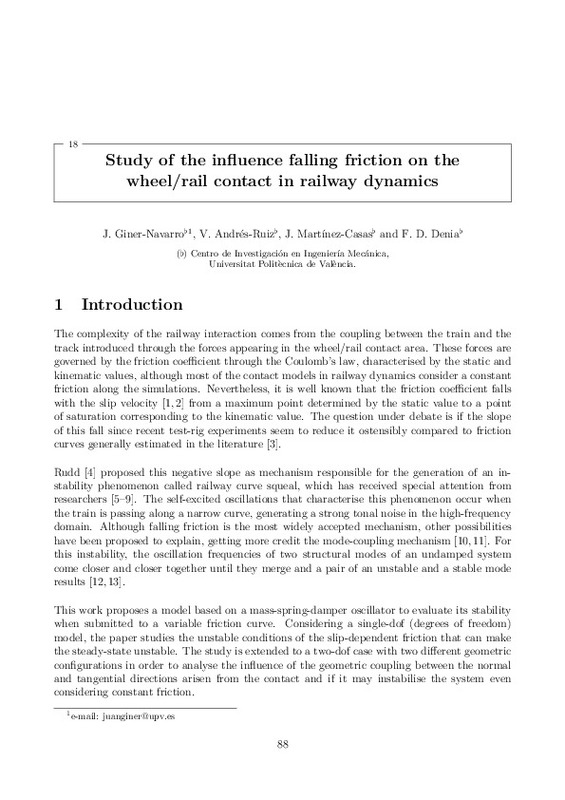JavaScript is disabled for your browser. Some features of this site may not work without it.
Buscar en RiuNet
Listar
Mi cuenta
Estadísticas
Ayuda RiuNet
Admin. UPV
Study of the influence falling friction on the wheel/rail contact in railway dynamics
Mostrar el registro sencillo del ítem
Ficheros en el ítem
| dc.contributor.author | Giner Navarro, Juan
|
es_ES |
| dc.contributor.author | Víctor Andrés-Ruiz
|
es_ES |
| dc.contributor.author | Martínez Casas, José
|
es_ES |
| dc.contributor.author | F. D. Denia
|
es_ES |
| dc.date.accessioned | 2022-02-07T08:28:40Z | |
| dc.date.available | 2022-02-07T08:28:40Z | |
| dc.date.issued | 2019-07-12 | es_ES |
| dc.identifier.isbn | 978-84-09-16428-8 | es_ES |
| dc.identifier.uri | http://hdl.handle.net/10251/180535 | |
| dc.description.abstract | The complexity of the railway interaction comes from the coupling between the train and the track introduced through the forces appearing in the wheel/rail contact area. These forces are governed by the friction coefficient through the Coulomb s law, characterised by the static and kinematic values, although most of the contact models in railway dynamics consider a constant friction along the simulations. Nevertheless, it is well known that the friction coefficient falls with the slip velocity [1,2] from a maximum point determined by the static value to a point of saturation corresponding to the kinematic value. The question under debate is if the slope of this fall since recent test-rig experiments seem to reduce it ostensibly compared to friction curves generally estimated in the literature [3]. Rudd [4] proposed this negative slope as mechanism responsible for the generation of an instability phenomenon called railway curve squeal, which has received special attention from researchers [5 9]. The self-excited oscillations that characterise this phenomenon occur when the train is passing along a narrow curve, generating a strong tonal noise in the high-frequency domain. Although falling friction is the most widely accepted mechanism, other possibilities have been proposed to explain, getting more credit the mode-coupling mechanism [10 11]. For this instability, the oscillation frequencies of two structural modes of an undamped system come closer and closer together until they merge and a pair of an unstable and a stable mode results [12 13]. This work proposes a model based on a mass-spring-damper oscillator to evaluate its stability when submitted to a variable friction curve. Considering a single-d.o.f. (degrees of freedom) model, the paper studies the unstable conditions of the slip-dependent friction that can make the steady-state unstable. The study is extended to a two-d.o.f. case with two different geometric configurations in order to analyse the influence of the geometric coupling between the normal and tangential directions arisen from the contact and if it may instabilise the system even considering constant friction. | es_ES |
| dc.description.sponsorship | The authors gratefully acknowledge the financial support of FEDER/Ministerio de Ciencia, Innovacion y Universidades Agencia Estatal de Investigacion (project TRA2017-84701-R), as well as Conselleria d'Educacio, Investigacio, Cultura i Esport (project Prometeo/2016/007) and European Commission through the project RUN2Rail - Innovative RUNning gear soluTiOns for new dependable, sustainable, intelligent and comfortable RAIL vehicles (Horizon 2020 Shift2Rail JU call 2017, grant number 777564). | es_ES |
| dc.language | Inglés | es_ES |
| dc.publisher | R. Company, J. C. Cortés, L. Jódar and E. López-Navarro | es_ES |
| dc.relation.ispartof | Modelling for Engineering & Human Behaviour 2019 | es_ES |
| dc.rights | Reserva de todos los derechos | es_ES |
| dc.subject.classification | INGENIERIA MECANICA | es_ES |
| dc.title | Study of the influence falling friction on the wheel/rail contact in railway dynamics | es_ES |
| dc.type | Comunicación en congreso | es_ES |
| dc.type | Capítulo de libro | es_ES |
| dc.relation.projectID | info:eu-repo/grantAgreement/AEI/Plan Estatal de Investigación Científica y Técnica y de Innovación 2013-2016/TRA2017-84701-R/ES/DESARROLLO DE UN MODELO INTEGRAL DE INTERACCION VEHICULO%2FVIA EN CURVA PARA LA REDUCCION DEL IMPACTO ACUSTICO DEL TRANSPORTE FERROVIARIO/ | es_ES |
| dc.relation.projectID | info:eu-repo/grantAgreement/GVA//PROMETEO%2F2016%2F007//Modelado numérico avanzado en ingeniería mecánica/ | es_ES |
| dc.relation.projectID | info:eu-repo/grantAgreement/EC/H2020/777564/EU/ | es_ES |
| dc.rights.accessRights | Abierto | es_ES |
| dc.contributor.affiliation | Universitat Politècnica de València. Departamento de Ingeniería Mecánica y de Materiales - Departament d'Enginyeria Mecànica i de Materials | es_ES |
| dc.description.bibliographicCitation | Giner Navarro, J.; Víctor Andrés-Ruiz; Martínez Casas, J.; F. D. Denia (2019). Study of the influence falling friction on the wheel/rail contact in railway dynamics. R. Company, J. C. Cortés, L. Jódar and E. López-Navarro. 88-93. http://hdl.handle.net/10251/180535 | es_ES |
| dc.description.accrualMethod | S | es_ES |
| dc.relation.conferencename | Mathematical Modelling in Engineering & Human Behaviour 2019 | es_ES |
| dc.relation.conferencedate | Julio 10-12,2019 | es_ES |
| dc.relation.conferenceplace | Valencia, Spain | es_ES |
| dc.relation.publisherversion | https://imm.webs.upv.es/jornadas/2021/past_editions.html | es_ES |
| dc.description.upvformatpinicio | 88 | es_ES |
| dc.description.upvformatpfin | 93 | es_ES |
| dc.type.version | info:eu-repo/semantics/publishedVersion | es_ES |
| dc.relation.pasarela | S\391645 | es_ES |
| dc.contributor.funder | Generalitat Valenciana | es_ES |
| dc.contributor.funder | SHIFT2RAIL JOINT UNDERTAKING | es_ES |
| dc.contributor.funder | AGENCIA ESTATAL DE INVESTIGACION | es_ES |
| dc.contributor.funder | European Regional Development Fund | es_ES |






